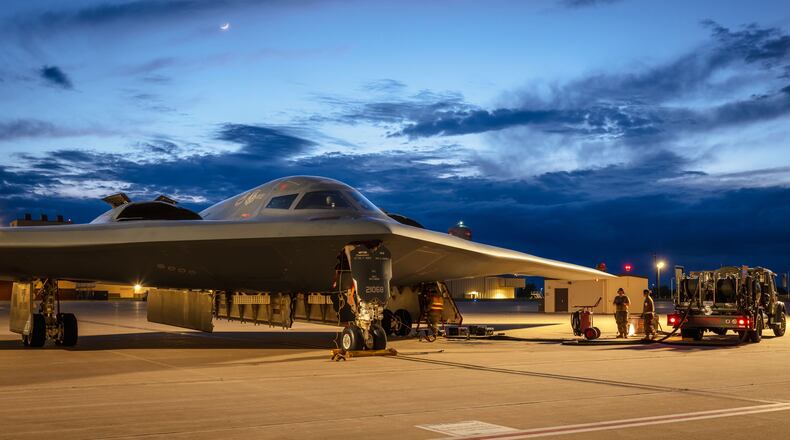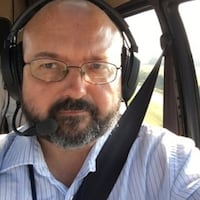It is thought that Iranian defense forces never knew the bombers were anywhere around until it was far too late.
“Iran’s nuclear facilities in Fordow, Isfahan, and Natanz were completely and totally obliterated,” a Pentagon spokesman told NBC News last week. “There is no doubt about that.”
Split between Wright-Patterson and Tinker Air Force bases, the Air Force says the program office overseeing the B-2 manages everything from sustaining the aircraft to delivering new technologies.
“It’s absolutely a team effort among the military, the government civilians who work at the various facilities and arsenals and depots who maintain them, and the contractors themselves that play an ongoing role,” Todd Harrison, a senior fellow at the American Enterprise Institute, told the Dayton Daily News.
From what we can tell, the operation over Iran went as intended, he added. The only question is whether one night of strikes is enough. “And that’s a political decision,” he said.
“We almost take it for granted because it seems so easy ... but if you step back and think about it, we launched planes from the middle of America, flew continuously to almost halfway around the world, dropped enormous bombs from each plane, hit the targets with incredible precision and flew back without those planes or their crews ever coming into serious threat of harm,” he added.
The Air Force flies 20 B-2 Spirits today. While operational details are sensitive, the aircraft is expected to remain in service for many years, well into the 2030s and possibly beyond.
“The Air Force is committed to maintaining and modernizing the B-2 to ensure it remains a credible, survivable, long-range strike asset until the B-21 Raider is fielded,” the system program office told the Dayton Daily News.
Credit: 1st Combat Camera Squadron
Credit: 1st Combat Camera Squadron
“Wright-Patterson Air Force Base plays a critical role in managing the sustainment of the US Air Force’s fleet and serves as the home of the Air Force Life Cycle Management Center,” noted Mike Stengel, a partner in AeroDynamic Advisory, a Washington, D.C.-based aerospace consulting firm.
“While headquartered at Tinker AFB in Oklahoma City, the Air Force Sustainment Center (AFSC) also has a heavy presence at Wright-Patterson,” Stengel added.
What follows is a transcript of an e-mail interview with the system program office, edited for space.
Dayton Daily News: Can you provide details about the history of the B-2’s design and refinement? How did the Air Force and Northrop Grumman (and the subcontractors) work together on its design?
B-2 program office: “The B-2 Spirit was conceived during the Cold War to provide the United States with a stealth, long-range, penetrating bomber able to deliver both conventional and nuclear payloads. The design process began in the late 1970s and 1980s, with Northrop, now Northrop Grumman, leading the prime contract.
“The Air Force and industry partners worked collaboratively through classified development phases to refine its unique flying-wing design and low-observable technologies. Dozens of subcontractors across the U.S. contributed to its systems and structures.
“Wright-Patterson Air Force Base played a significant role from the earliest phases. The Aeronautical Systems Division, a predecessor to today’s Bombers Directorate, provided program management, systems engineering oversight, and testing support. WPAFB personnel were critical in requirements definition, risk reduction, and lifecycle sustainment planning — efforts that continue to this day.”
DDN: What was the principal need that inspired the B-2?
“To ensure the U.S. could penetrate advanced, integrated air defense systems and hold any target at risk globally. During the Cold War, adversary air defenses were becoming increasingly sophisticated. A stealth bomber capable of flying long distances undetected was seen as essential to maintain credible nuclear deterrence and conventional strike capabilities.”
DDN: How many people manage the bomber at Wright-Patterson today? How many at Tinker?
“There are over 350 government and military personnel providing support to the B-2 across both program office locations, roughly 200 at Tinker Air Force Base, and approximately 150 at Wright-Patterson AFB. Not to mention our industry partners at Northrop Grumman executing our depot aircraft maintenance mission in Palmdale, Calif.”
DDN: What is involved in updating the B-2?
“Modernizing the B-2 is a comprehensive effort to keep the platform viable and lethal against evolving threats. Updates involve all of the above: new software, avionics upgrades, structural modifications, low-observable materials improvements, communications enhancements, and weapons integration.
“The Bombers Directorate at Wright-Patterson ... leads the program management, contracting, and integration of these modernization efforts in partnership with Northrop Grumman and other contractors.
“Feedback from operational units — including pilots, maintainers, and commanders — is essential. Their insights shape requirements and priorities to ensure the B-2 remains capable of meeting mission needs today and in the future."
DDN: How does it feel watching the plane perform today?
“Everyone involved in the B-2 program — from its original design teams to today’s engineers, maintainers, and aircrew — takes great pride in seeing the aircraft perform its mission. The B-2 represents decades of innovation and commitment to national defense. Watching it remain at the forefront of the Air Force’s global strike capability is a testament to the dedication of thousands of people across the Air Force, industry, and partner organizations."
About the Author



